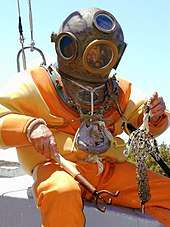Cold shock response
Cold shock response is the physiological response of organisms to sudden cold, especially cold water.
In humans, cold shock response is perhaps the most common cause of death from immersion in very cold water,[1] such as by falling through thin ice. The immediate shock of the cold causes involuntary inhalation, which if underwater can result in drowning. The cold water can also cause heart attack due to vasoconstriction;[2] the heart has to work harder to pump the same volume of blood throughout the body. For people with heart disease, this additional workload can cause the heart to go into arrest. Inhalation of water (and thus drowning) may result from hyperventilation. Some people are much better able to survive swimming in very cold water due to body or mental conditioning.[1]
Hypothermia from exposure to cold water is not as sudden as is often believed. A person who survives the initial minute of trauma (after falling into icy water), can survive for at least thirty minutes provided they don't drown. However, the ability to perform useful work (for example to save oneself) declines substantially after ten minutes (as the body protectively cuts off blood flow to "non-essential" muscles).[1]
Physiological response
The physiological response results into temporary breathlessness.
Conditioning against cold shock
It is possible to undergo physiological conditioning to reduce the cold shock response, and some people are naturally better suited to swimming in very cold water. Adaptations include the following:
- having an insulating layer of body fat covering the limbs and torso without being overweight;[1]
- ability to experience immersion without involuntary physical shock or mental panic;[1]
- ability to resist shivering;[1]
- ability to raise metabolism (and, in some cases, increase blood temperature slightly above the normal level);
- a generalized delaying of metabolic shutdown (including slipping into unconsciousness) as central and peripheral body temperatures fall.
In these ways, winter swimmers can survive both the initial shock and prolonged exposure. Nevertheless, the human organism is not suited to freezing water: the struggle to maintain blood temperature (by swimming or conditioned metabolic response) produces great fatigue after thirty minutes or less.[3]
Cold shock response in bacteria
Bacteria express a well-defined set of proteins after a rapid decrease in temperature, which differ from those expressed under heat shock conditions. Cold shock proteins may include helicases, nucleases, and ribosome-associated components that interact with DNA and RNA. Processes such as cold signal perception, membrane adaptation, and the modification of the translation apparatus are involved.[4]
See also
References
- 1 2 3 4 5 6 "Exercise in the Cold: Part II - A physiological trip through cold water exposure". The science of sport. www.sportsscientists.com. 29 January 2008. Retrieved 2010-04-23.
- ↑ Staff. "4 Phases of Cold Water Immersion". Beyond Cold Water Bootcamp. Canadian Safe Boating Council. Retrieved 8 November 2013.
- ↑ Janský, L.; Janáková, H.; Ulicný, B.; Srámek, P.; Hosek, V.; Heller, J.; Parízková, J. (1996). "Changes in thermal homeostasis in humans due to repeated cold water immersions". Pflügers Archiv : European Journal of Physiology. 432 (3): 368–372. doi:10.1007/s004240050146. PMID 8765994.
- ↑ Weber, M. H.; Marahiel, M. A. (2003). "Bacterial cold shock responses". Science Progress. 86: 9–75. PMID 12838604.
Sources
- Introduction to Frozen Mythbusters and Myth #1. Wilderness Medicine Newsletter. Sourced 2008-05-17.
